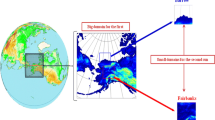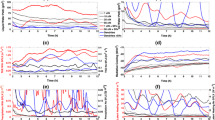Abstract
Water vapor transfer processes in clouds were examined as they apply to the formation of ice crystals on solver iodide particles acting as ice forming nuclei. Part of the water vapor released from freezing cloud droplets is available for recondensation on aerosol particles active as condensation nuclei at high supersaturations. Calculations have shown that the combination of a high liquid water content, an updraft, and a large concentration of submicron silver iodide particles is required for rapid formation of ice crystals in a seeded cloud. Ice crystal concentrations produced by the recondensation of water vapor on silver iodide particles are orders of magnitude larger than concentrations resulting from Brownian diffusion of silver iodide particles to cloud droplets. Ice formation by this mechanism provides a satisfactory explanation of seeding efficacy in severe storms.
Zusammenfassung
Die Transport-Mechanismen von Wasserdampf in Wolken wurden im Hinblick auf die Bildung von Eiskristallen an Silberjodidteilchen als Eiskerne untersucht. Ein Teil des Wasserdampfes der während des Gefrierens von Wolkentröpfchen abgegeben wird, kann an Aerosolteilchen, die als Kondensationskerne bei hohen Übersättigungen wirksam sind, wieder kondensieren.
Rechnungen zeigen, daß ein Zusammenwirken von hohem Gehalt an Flüssigwasser, starken Aufwinden und einer hohen Konzentration von Submikron-Silberjodidteilchen nötig ist, um eine rasche Bildung von Eiskristallen in der geimpften Wolke hervorzurefen. Die Eiskristallkonzentration, die durch die Wiederkondensation von Wasserdampf an Silberjodidteilchen verursacht wird, ist um Größenordnungen höher, als die Konzentrationen, die durch Brownsche Diffusion von Silberjodidteilchen zu Wolkentröpfchen hervorgerufen werden. Die Eisbildung aufgrund dieses Mechanismus erklärt die Wirksamkeit der Silberjodidimpfung in schweren Gewittern zufriedenstellend.
Similar content being viewed by others
Abbreviations
- a, b :
-
constants
- B :
-
ventilation factor
- C :
-
heat capacity
- c p,c pi,c pn :
-
specific heat of air, ice, and water
- D' :
-
diffusion coefficient of water vapor
- D(s):
-
Brownian diffusion coefficient
- enn h(r) :
-
enhancement function
- f i :
-
fraction of ice in a freezing droplet
- f (r):
-
droplet number distribution
- G :
-
mass of liquid water in a freezing droplet
- g(r):
-
ice crystal number distribution
- h(s):
-
aerosol particle number distribution
- I :
-
proportionality factor indicating the dependence of particle capture rate on the droplet and on ice crystal size distribution
- K :
-
thermal conductivity of air
- K (r):
-
particle concentration number density
- L f :
-
latent heat of freezing
- LR :
-
lapse rate
- m :
-
mass
- N :
-
inactive AgI particle number density per unit volume of cloud water
- N a dr dt :
-
total number of active AgI particles received by a group of droplets
- P(s):
-
number density (aerosol)
- q, Q :
-
heat
- Q (r):
-
number density (droplets)
- r :
-
radius of cloud droplet or of ice crystal
- r', l :
-
distance
- Re(r):
-
Reynolds number
- r' (T):
-
radius of AgI particles above which particles are active as ice forming nuclei
- s :
-
radius of aerosol particle
- S :
-
water vapor saturation
- \(\vec S\) :
-
surface element
- t :
-
time
- T :
-
temperature of supercooling (environment)
- T r :
-
droplet surface temperature
- v :
-
droplet terminal velocity
- V(r, T) :
-
supersaturated volume produced by a single freezing droplet
- V a(t):
-
total supersaturated volume per unit time
- x, z :
-
distance
- α, β, γ:
-
constants
- κ:
-
thermoconductivity
- ρ:
-
environment water vapor density
- ρ a :
-
density of air
- ρ r :
-
water vapor density at the surface of a droplet
- ρ w :
-
water density
- τ:
-
boundary layer thickness
- χ:
-
thermal diffusivity
References
J. Rosinski andT. C. Kerrigan, J. Atmos. Sci.26, 695 (1969); Corrigendum 27, 178 (1970).
G. K. Sulakvelidze,Rainstorms and Hail, TT68-50466 (US Dept. of Commerce, Springfield, Virginia 1969).
J. Rosinski, G. Langer, C. T. Nagamoto, T. C. Kerrigan andF. Prodi, J. Atmos. Sci.28, 391 (1971).
A. Gagin, J. Rech. Atmos.4, 115 (1969).
G. Langer, J. Rosinski andC. P. Edwards, J. Appl. Meteor.6, 114 (1967).
G. Langer, in: Second National Conference on Weather Modification, 6–9 April (Santa Barbara, California 1970), p. 352.
G. Langer andJ. Weickmann, in press, Dessens Memorial Issue of the J. Rech. Atmos.
H. K. Weickmann andH.J. Aufm Kampe, J. Meteor.10, 204 (1953).
N. A. Fuchs,Evaporation and Droplet Growth in Gaseous Media (Pergamon Press, New York 1959).
L. O. Landau andE. M. Lifschitz,Fluid Mechanics (Pergamon Press, London 1959).
N. A. Fuchs,The Mechanics of Aerosols (The Macmillan Co., New York 1964), p. 181 and 27.
L. Facy, Arch. Met. Geophys. Bioklim.A8, 229 (1955).
Author information
Authors and Affiliations
Additional information
The National Center for Atmospheric Research is sponsored by the National Science Foundation.
Rights and permissions
About this article
Cite this article
Rosinski, J., Kerrigan, T.C. Mechanism of ice formation in seeded convective storms. Journal of Applied Mathematics and Physics (ZAMP) 23, 277–300 (1972). https://doi.org/10.1007/BF01593092
Received:
Revised:
Issue Date:
DOI: https://doi.org/10.1007/BF01593092




